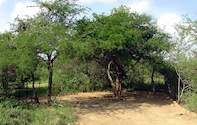
The Limpopo National Park (LNP) existed as a hunting concession in Mozambique, known as Coutada 16, since 1969.The area which comprises one million hectare was upgraded to a national park in 2001 as part of Mozambique's commitment to the Great Limpopo Transfrontier Park. Unlike its South African counterpart, the Kruger National Park, where there are no people living in the park, the LNP has many people living in unfenced villages inside the Park, trying to make a living from subsistence farming.
It is estimated that more than 31 000 people and their livestock live inside the LNP. Most of the people (approximately 25 000) live in 45 villages which are situated on the southern and northern banks of the Limpopo and Olifants Rivers on the periphery of the park. Approximately 6000 people live in eight villages within the Shingwedzi River basin in the interior of the Park. The people of Coutada 16 were always part of the bigger Transfrontier Conservation Area (TFCA).
The German Development Bank (Kreditanstalt fur Wiederaufbau -KfW) provided the initial funding to the Mozambican Ministry of Tourism to initiate the development of the Limpopo National Park. The Ministry mandated the Peace Parks dation to assist the National Directorate of Conservation Areas in overseeing the development of the LNP. The first task was to draft a management plan for the park and Dave Grossman was appointed as lead consultant. He initiated a consultative process with the local communities and other role players.

Although no provision was made for resettlement in the beginning, it later surfaced during the management planning process that the community wanted the option to choose if they want to live with or in between the increasing number of wildlife or if they would prefer to be resettled outside the park.
"They want to resettle," said Arrie van Wyk, project manager at the LNP. "For many it would mean a third displacement in their life time. The first was when the Massingir dam was built in the 1970s and people on the banks of the Olifants River that were farming in the rich alluvial land had to move to higher ground.
War Broke Out
Soon after the completion of the dam, the war broke out, and once again, people had to move - some went to bigger villages in the area, while others fled to South Africa." After the war, many people returned to Mozambique, some settling in the small villages in Coutada 16. Some were even assisted with formal repatriation programmes underlined by the United Nations and other aid agencies, as well as the Mozambican Government.
They had just settled when the LNP was declared a national park and they faced disruption again. "The people accept the fact that the Government wants to develop the park and realise that they will benefit in some way but they want to move for the last time now," says Arrie. The original thinking was that the communities would continue to stay in the park and live as enclave communities and carry on with their agricultural activities. After the consultative process, however, it was clear that the communities who live in the Shingwedzi basin do not want to live with wildlife.
They also realise that it will be difficult for government to provide them with social services such as schools, clinics etc when they are living isolated in the middle of the park. KfW agreed to source additional funding on condition that resettlement must be absolutely voluntary. The process was set in motion with the adoption of a resettlement framework based on principles as set out by the World Bank.
Village steering committees were established in the various villages to act as representative structures. The leaders from the village steering committees were elected to a Resettlement Working Group who had the opportunity and responsibility to analyse, scrutinise, adapt and approve the resettlement framework.
Resettled to Villages
Residents of Macavane, a village about two kilometres inside the Park, negotiated to be resettled to a village called Banga which is outside the park but still near the Massingir Dam. According to Arrie, this will be regarded as a pilot project and will affect about 100 families in Macavene and about 20 families in the nearby Nangene village, which also indicated that they want to be resettled. At the last meeting, all eight villages in the interior of the LNP, comprising about 1000 families, indicated that they are prepared to move as villages and not individuals.
All eight villages, on their own accord, had made contact with other villages to act as potential'host' communities, following up on historical ties from before and since the war. According to Arrie, a compensation framework will now be established for Macavene and Nangene where a socio-economic evaluation of the town as a whole and every family individually will be conducted. This will include an asset evaluation of every family. Every household is entitled to a plot at the new village where aspects such as water provision, schools, clinic, roads etc are all taken into account.
Each household will be given a written offer to resettle and will be assisted with the transportation of their goods. The offer will contain the replacement of their existing house. Different categories of houses have been identified based on the size of the house as well as the material used. Once all goods have been moved, the structures and everything that had remained will be destroyed.
The LNP will also assist each family with the development of their livelihoods at the resettlement site. A small irrigation plot (one hectare per family) as well as dry land cultivation is foreseen. The LNP hopes to finalise the Resettlement Action Plan for Macavene and Nangene by June this year. Arrie says it would be preferable for people to have moved by October, before the start of the next seasonal rains.

